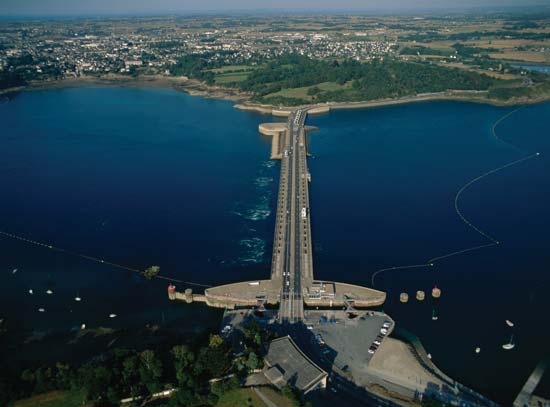tidal power
energy
 any form of renewable energy in which tidal action (ocean) in the oceans is converted to electric power.
any form of renewable energy in which tidal action (ocean) in the oceans is converted to electric power.There are a number of ways in which tidal power can be harnessed. Tidal barrage power systems take advantage of differences between high tides (tide) and low tides by using a “barrage,” or type of dam, to block receding water during ebb periods. It is the subsequent release of the water through a turbine that generates electricity as the tide rises; a similar process occurs in hydroelectric dams. Tidal stream power systems take advantage of ocean currents (ocean current) to drive turbines, particularly in areas around islands or coasts where these currents are fast. They can be installed as tidal fences—where turbines are stretched across a channel—or as tidal turbines, which resemble underwater wind turbines (see wind power). Wave power systems use the up-and-down motion of waves to drive energy production and can be installed in shoreline areas as well as offshore. Generally, the areas of greatest potential for wave energy development are the latitudes with the highest winds (latitudes 40°–60° N and S) on the eastern shores of the world's oceans. For this reason, a large potential for wave power systems exists in the British Isles and the Pacific Northwest of the United States.
Many tidal power technologies are not available at an industrial scale, and thus tidal energy contributes a negligible fraction of global energy today. There is, however, a large potential for its use, because much usable energy is contained in water currents. The total energy contained in tides worldwide is 3,000 gigawatts (GW; billion watts), though estimates of how much of that energy is available for power generation by tidal barrages are between 120 and 400 GW, depending on the location and the potential for conversion. By comparison, a typical new coal-based generating plant produces about 550 megawatts (MW; million watts). For wave energy, one estimate is 2,000 terawatt-hours per year (approximately 10 percent of global electricity production), and tidal stream power—which uses ocean currents to drive underwater blades in a manner similar to wind power generation—in shallow water can generate some 3,800 terawatt-hours per year (one terawatt is 1 × 1012 watts).
By the early 21st century, some of these technologies had become commercially available. A tidal barrage power station at La Rance in France has been operating since the 1960s, with 240 MW of capacity; its typical output is 0.5 terawatt-hour per year. A prototype wave power station located near the island of Islay, Scotland, has a capacity of 0.5 MW. Because few tidal current plants exist, the costs of this technology are not known, but it is expected that costs would be lower than for tidal barrage systems.
Environmental concerns raised about tidal power stations are largely focused on the tidal barrage systems, which can disrupt estuarine ecosystems during their construction and operation. Tidal fences and turbines are expected to have minimal impact on ocean ecosystems. Tidal fences do have the potential to injure or kill migratory fish, however, but these structures can be designed to minimize such effects.
- Robin Maugham
- Robins, Benjamin
- Robins, Margaret Dreier
- robinsonade
- Robinson, Bill
- Robinson, Boardman
- Robinson, Brooks, Jr.
- Robinson, Eddie
- Robinson, Edward
- Robinson, Edward G.
- Robinson, Edwin Arlington
- Robinson, Frank
- Robinson, Harriet Jane Hanson
- Robinson, Henry Crabb
- Robinson, Henry Peach
- Robinson, Henry Wheeler
- Robinson, Jackie
- Robinson, James Harvey
- Robinson Jeffers
- Robinson, Joan
- Robinson, John
- Robinson, Joseph T
- Robinson, Lennox
- Robinson, Mary
- Robinson, Max